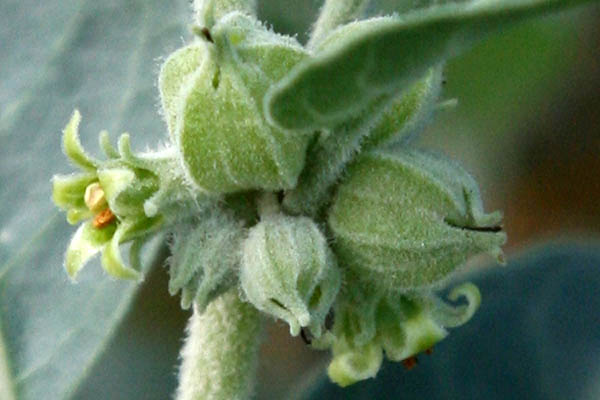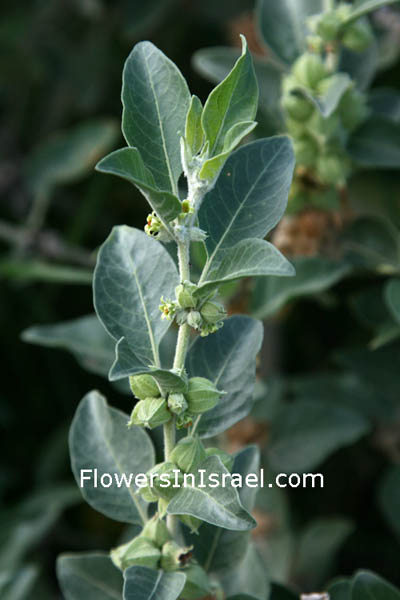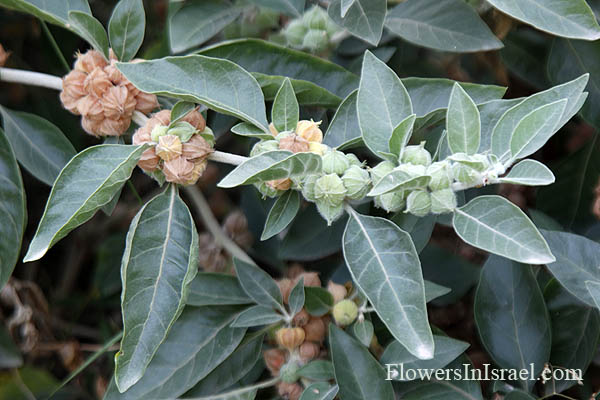Common Winter-cherry, Sleepy nightshade, Ashwagandha,
Hebrew: ויתניה משכרת, Arabic: العبعب المنوم, Egypt: سم الفراخ "Simm Frakh"
| Scientific name: | Withania somnifera (L.) Dunal | |
| Synonym name: | Physalis somnifera L. | |
| Common name: | Common Winter-cherry, Sleepy nightshade, Ashwagandha | |
| Hebrew name: | ויתניה משכרת | |
| Arabic name: | العبعب المنوم | |
| Egypt: | سم الفراخ "Simm Frakh" | |
| Plant Family: | Solanaceae, סולניים |

|
| Life form: | Chamaephyte | |
| Stems: | 30-150 cm tall, pubescent with dendritic hairs; woody proximally, erect or reclining, branched, tomentose | |
| Leaves: | Alternate; ovate, obovate, or oblong; entire, dentate or serrate | |
| Flowers: | Corolla bell-shaped with 3-6 yellow-green lobes; yellow petals on the inside but with a green outer-covering layer | |
| Fruits / pods: | Berry, shiny, red, globose, 5-8 mm, in papery protective covering (calyx) | |
| Flowering Period: | Summer | |
| Habitat: | Rich soils, ruderal | |
| Distribution: | The Mediterranean Woodlands and Shrublands, Semi-steppe shrublands, Shrub-steppes, Deserts and extreme deserts | |
| Phytogeo: | Med - Irano-Turanian | |
| Summer shedding: | Perennating |

Derivation of the botanical name: Withania for withanine, the main constituents of this plant. somnifera, somnifer, sleep bringing ; meaning sleep inducing. The name ashwagandha (one of the common names for this herb) comes from the sanskrit meaning "horse-like-smell". Apparently, this name not only refers to the smell of the herb but also its strengthening and aphrodisiac qualities. It is sometimes called “Indian Ginseng”. The Hebrew name: ויתניה, withania, the foreign name transliterated to Hebrew.
'Plant narcotic, anti-epileptic, used for stomachache, ulcers, colds; roots for the treatment of rheumatic pains, calmative; leaves and fruits rebrifuge, diuretic, antirheumatic; seeds toxic, emetic, anesthetic.' 'Withania somnifera: A Rejuvenating Ayurvedic Medicinal Herb for the Treatment of various Human ailments. In Ayurveda, Withania somnifera, Ashwagandha is considered as a rasayana* herb, which works on a nonspecific basis to increase health and longevity. Withania somnifera has been in use for over 2500 years to treat all kind of diseases and human ailments.' 'Withania somnifera possess good immunomodulatory anti-inflammatory, antitumor, antioxidant, anticancer properties and many pharmacologically and medicinally important chemicals, such as Withaferins, sitoindosides and various alkaloids, they protect the cells from oxidative damage and diseases.' *rasayana, a term that in early ayurvedic medicine means the science of lengthening lifespan. 
Location: Maagan Kibbutz Holiday Village - Sea of Galilee |